You can make fun of me if you like: one thing is certain that this music in this isolated place appears like the work of the devil.
It is too loud to be natural and it has such a sad and special manner that it could not be compared to any other music in Christendom.George Sand about the music of the hurdy-gurdy.
In: Les Maitres Sonneurs – 1853.
The History of the Hurdy-Gurdy
The origin of the hurdy-gurdy remains unclear. Source material provides no specific proof that the instrument was used in the East before its appearance in Europe. During the Gothic period a large ancestor of the hurdy-gurdy, the organistrum, was used in cloisters and monastic schools to teach music, perform religious polyphony and provide correct intonation for the congregational singing. The name "organistrum" was probably derived from the Latin "organum," meaning in its broadest sense an instrument on which several parts of the instrument's "body" are adapted to a certain function and working together analogous to the organ. Due to the size of the organistrum (between one and a half and two metres long and fiddle-or guitar shaped), it must be played by two men, set horizontally across their laps. One man operated the tangents while the other turned the crank, making the three strings sound simultaneously. The pitches on an organistrum were set according to Pythagorean temperament. An early depiction of an organistrum is to be found in the cathedral of Santiago de Compostela (Spain, 1168–1188) in a sculpture over the "Portico de la Gloria."
The most important role of the hurdy-gurdy was its function in secular music. During the early thirteenth century it had been completely transformed into a much smaller, portable device known as a chifonie (French) or symphonia (from Greek sym-phonos = harmonious sounds), played by a single musician. Numerous literary references from the Middle Ages show that the hurdy-gurdy was found among other string instruments, usually paired with the plucked varieties. Sometimes it was associated with bourdon instruments such as the vielle (the medieval fiddle).
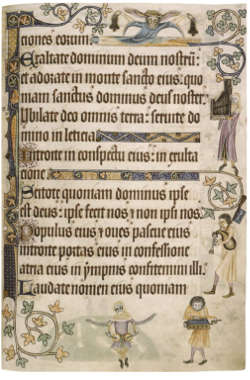
Michael Praetorius' Syntagma Musicum
(Leipzig 1619). Plate XVII.
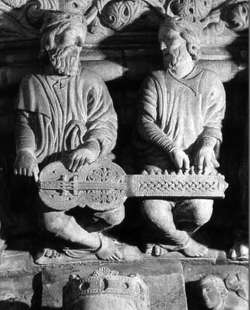
Santiago de Compostela, Spain.
The hurdy-gurdy was frequently used to accompany the chansons de geste with instrumental preludes and interludes and, when appropriate, to double the vocal line. Although the hurdy-gurdy found many supporters in secular life during the fifteenth century, there is evidence from various depictions that it was still popular in religious circles. One fine example is an illustration from the Italian manuscript, called the Sforza Book of HoursIllustrated by Giovan Pietro Birago, but with Flemish insertions from 1517–1520. Milano, c. 1490) today housed in the British Library London (3 for images). A page with an Alleluya hymn shows as a decorative motif an angel playing an oval-shaped hurdy-gurdy, similar to the commonly known form, with seven or eight keys (some are hidden by the angel's hand), giving it a range of an octave.Susann Palmer, Samuel Palmer: The Hurdy-Gurdy (Exeter, Devon: 1980), 85f.
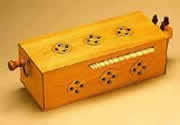
The early medieval form of the hurdy-gurdy was the box-shaped symphonia, here a reconstruction according to the motifs in the Luttrell Psalter.
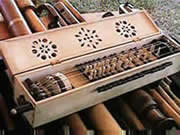
The hurdy-gurdy eventually left the cloister environment altogether and became firmly established as a minstrel instrument. Its spread was facilitated by wandering minstrels and troubadours, who found employment in increasing numbers at the flourishing courts and towns. Gradually, the church began to accept their participation in religious processions and similar events. In this way the hurdy-gurdy insinuated itself into every social level of Western society, from the nobility to simple village peasants. One could hear it as an accompaniment to dance music as well as in the orchestra at the popular mystery plays.
The reputation of the hurdy-gurdy began to slowly decline as increasing numbers of poor took it up in order to eek out a meager living although some had hoped to aspire to the status of the troubadours who received generous compensation ("laden with gifts"). However, due the swelling numbers of hurdy-gurdy players and the shift in musical taste which demanded greater polyphonic capabilities than the hurdy-gurdy could offer, the instrument fell out of favor amongst the nobility and was relegated to the very lowest social classes composed of peasants, beggars and blind musicians.Extensive research to the subject of blind beggars playing the hurdy-gurdy in sixteenth-/seventeenth Dutch painting is made by Kahren Jones Hellerstedt, "Hurdy-gurdies from Hieronymus Bosch to Rembrandt" (unpublished thesis, University of Pittsburgh, 1980).
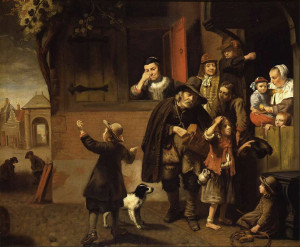
Nicolaes Maes
c. 1656/58
Dordrechts Museum
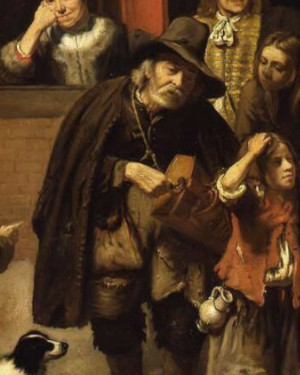 De liereman (detail)
De liereman (detail)(The hurdy-gurdy player, detail)
Nicolaes Maes
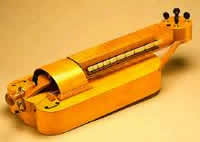
As a result of its decline in prestige the hurdy-gurdy was tagged with names like the German Bauernleier (peasant's lyre) or Bettlerleier (beggar's lyre). While Michael Praetorius in his Syntagma Musicum (1619) called it the Bawren vnnd vmblauffenden Weiber Leyre ("a lyre for peasants and traipsing women"), Marin Mersenne in his Harmonie universelle (1636) specifically calls it a blind beggar's instrument, "played only by the poor, and particularly by the blind who earn a living with the instrument."Kahren Jones Hellerstedt, "Hurdy-gurdies from Hieronymus Bosch to Rembrandt" (unpublished thesis, University of Pittsburgh, 1980), 206 (with notes 1 and 2). Susann Palmer, Samuel Palmer: The Hurdy-Gurdy (Exeter, Devon: 1980), 101.
The loss of the hurdy-gurdy's respectability is evident in almost all paintings of the time showing a hurdy-gurdy player. A decree from 1651 had already instructed the public order official to make sure that travelling musicians had proper licenses: "The hurdygurdyists, both men and women should be removed completely so that we no longer need to see their vulgar and disorderly talk and gestures which the traveling musicians delight in cultivating together with other impertinances." Paintings by Brueghel and Bosch also reflect the negative symbolic value imputed to the hurdy-gurdy by emphasizing a supposed connection between physical and moral blindness (see also below: Kahren Jones Hellerstedt).
David Vinckboons
1606
Oil on panel, 43.2 x 73.6 cm.
Private collection
The hurdy-gurdies represented in Dutch/Flemish seventeenth century paintings generally refer to the Renaissance form as it appears in Michael Praetorius' Syntagma Musicum (Leipzig 1619). These were universally playable instruments adapted for Renaissance and early Baroque dance music and for the accompaniment of ballads.
In the late seventeenth century, the hurdy-gurdy enjoyed a rebirth at the French court since it appeared to evoke the nostalgia of rustic past. During the reign of Louis XIV the Arcadian ideal of the tranquility of a country life in accordance with nature, gained great favor at the court. The king frivolously indulged in every kind of rural pastime, and the whole court followed. About 1720, the great Versailles luthier Henri Bâton developed the classic lute and guitar shapes used for hurdy-gurdies to the present day. He also improved its harsh, rasping sound, making it more suitable for chamber music. His son Charles wrote numerous suites and sonatas for one or two hurdy-gurdies with and without continuo as well as chamber concertos for the hurdy-gurdy together with other instruments. Other builders such as Pierre and Jean Louvet (middle eighteenth century) or Jean-Nicolas Lambert sought to improve the capabilities of the instrument. Their instruments possess a remarkable beauty, inlaid with pearl and surmounted by a carved head at the end of the pegbox.

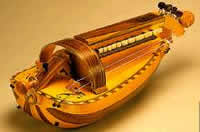
During the eighteenth century the hurdy-gurdy shared its repertory with the small bagpipe, the musette or "musette de cour" (see The Bagpipe). However, since the encompasses of the two instruments were different, their repertories, though overlapping, were not interchangeable. Furthermore, while the hurdy-gurdy remained largely an amateur instrument, the musette gained a permanent place in the opera orchestra, especially for the popular pastoral plays of the time. Numerous composers, such as Joseph Bodin de Boismortier, or the aforementioned Charles Bâton, and even Wolfgang Amadeus Mozart and Antonio Vivaldi wrote music for the hurdy-gurdy.
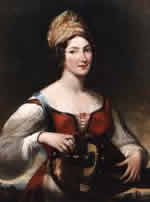
By 1760, the hurdy-gurdy had begun to decline as a salon instrument, but it continued to be used for playing arrangements of popular tunes, especially by street musicians. The tradition of the Savoyards,Susann Palmer, Samuel Palmer: The Hurdy-Gurdy (Exeter, Devon: 1980), 135–140. who had fled the poverty of their homeland to make their living on the streets playing the hurdy-gurdy, provided stories for many musical stage works. In the nineteenth century, the hurdy-gurdy was found throughout central France and in parts of Brittany, northern France and Belgium. It was frequently played with bagpipes for public dances and at weddings where the repertory consisted of waltzes, mazurkas, bransles and bourrées.
By the twentieth century the hurdy-gurdy began to die out, but in the revival of folk traditions in the 1960s it arose again and led to the foundation of festivals (above all in Saint Chartier, Indre départment, central France) and even a hurdy-gurdy museum at Montluçon (Auvergne, France) which possesses one of the largest collections of its kind, now serving as center for studies. Today the hurdy-gurdy is occasionaly employed by rock and jazz musicians.
The Structure, Tuning and Playing Technique of the Hurdy-Gurdy
British Library London
The hurdy-gurdy generally consists of three basic structural elements: a set of melody and drone (or bourdon) strings, a resin-coated wooden wheel, usually made of pear wood, which when rotated by a crank acts as a violin bow, and a keyboard with tangents (small wedges, usually made of wood and arranged in two or three rows, see below right) which are pressed against one or more of the strings to change their vibrating length, and therefore pitch. The strings are usually made of gut as they still are today, although metal strings have become common in the twentieth century, especially for the heavier drone strings. Cotton wool is spun around the strings where they come into contact with the wheel in order to soften the sound and encourage the drone strings to "speak." The melody strings pass through the keybox where they are touched by the tangents, over the wheel and over a bridge secured between the wheel and tailpiece, to which they are fastened. The drone strings (up to four in the common French hurdy-gurdy) pass over the table outside the keybox, usually two on either side of the box. They are held in position, after leaving their pegs, on small subsidiary bridges or nuts which protrude from the side of the keybox at the junction with the pegbox. They produce steady sounds (bourdon) at fixed pitches by vibrating against the edge of the wheel, but any of them can be temporarily placed out of action by securing them behind tiny studs, provided on the table, or by moving their positions on their respective bridges. These bridges are adjacent the main bridge for the melody strings and are also parallel to the wheel.
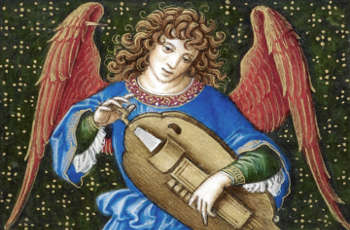
During the Renaissance period, a buzzing bridge appeared in depictions of the instrument (see above Hieronymus Bosch). This special bridge (commonly called the dog, French: chien) is asymmetrical and rests under the trompette, the highest-pitched drone string, on the soundboard. When the wheel is accelerated, one foot of the bridge (the hammer) lifts up from the soundboard and vibrates, creating a unique buzzing sound. The buzzing bridge is thought to have been borrowed from the tromba marina, a rare monochord bowed string instrument with a trumpetlike sound. The sensivity of the buzzing bridge can be controlled by a tierant, a small peg attached at the tailpiece of the instrument.
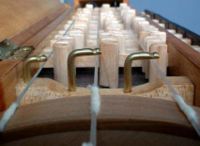

Click here for period hurd-gurdy music:
Contredanse
A Flemish tune, performed by Iep Fourier on the hurdy-gurdy.
From the album Speelman, Gij Moet Strijken. Traditionele muziek uit Vlaanderen/Traditional
Music from Flanders
With kind permission by Davidsfonds, Belgium.
( Association for Flemish Culture)
The other drone strings are the mouche (pitched a fourth or fifth below the trompette), the petit bourdon (an octave below the trompette) and the gros bourdon (an octave below the mouche). The melody strings (two or three) are called chanterelles (English: chanters) and are placed within the keybox. They are stopped by the tangents attached to keys that alter the vibration length of the string, like fingers do with the lute-, guitar- or violin strings. Most contemporary hurdy-gurdies have twenty-four keys that cover a range of two chromatic octaves.
In the early times of the hurdy-gurdy, tunings varied widely, with equal temperament most common in order to allow for easier blending with other instruments. The common French hurdy-gurdy is generally tuned in C or G, whereas the melody strings are always tuned to G1. Other, rather period tunings include the "Bourbonnais" tuning in D, while those in A and E are particularly found in Hungary and Eastern Europe.
The strings can be tuned manipulating the tuning pegs inserted in the pegbox, the tangents can be adjusted to tune individual notes by swivelling them around. Nowadays it is possible to tune hurdy-gurdies to almost any temperament.Detailed explanation to the structure of the hurdy-gurdy (with sound-examples to the single drones) is given by bagpiper and hurdy-gurdy player Sean Folsom at Oliver Seeler's website Universe of Bagpipes.
Playing the hurdy-gurdy requires considerable skill. The instrument is hung around the neck or strapped to the body at an angle that allows the keys to fall back under their own weight. For most solo instrumental work no more than three drone strings are used, four drones being too overpowering. For song accompaniment, a lesser number of drones is normally used and very often only one chanterelle, giving a softer, sweeter sound that blends readily with the human voice. Many medieval and Renaissance compositions use only one drone or none at all, depending on the player's personal taste and style. The right hand turns the crank to rotate the wheel. By minute interruptions of the wheel's rotation a clearly articulated percussive rhythm can be produced with the trompette drone and its buzzing bridge, advantageous especially for dance music to accentuate the specific rhythm of the dance.
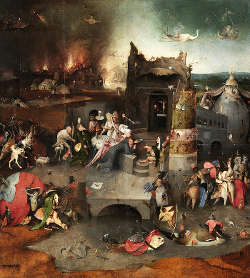
Hieronymus Bosch
c. 1505–1506
central paneel
Museu Nacional de Arte Antiga, Lisbon
The melody is played by the four fingers of the left hand (the thumb is never used), lightly but firmly touching the keys, similar to piano- or accordion-playing. But there exist no set rules that certain fingers must be used for certain keys. Fingering depends primarily on the music being played, its tempo and the succession of notes. The general rule is to simply use the fingers that come most comfortably for a particular piece of music.
The hurdy-gurdy is not an easy instrument to master (many of the musicians who play several instruments believe it is one of the most difficult) and some even appear to have become completely obsessed by it. It is ideal for traditional folk-music, and if well played, it can be extraordinarily beautiful. If the handle is correctly turned, the trompette-string produces a pronounced rhythmical effect which makes its music irresistible.
Hieronymus Bosch,
c. 1500
Museo del Prado Madrid.
This wing shows a most violent vision of the hell, sometimes also called 'the musical hell'. The musical instruments, among them a large hurdy-gurdy, often connotations. Here they shall symbolize the various cruel practices of the torture of defenseless people probably referring to that of the inquisition.
"To the subject of a blind beggar playing the hurdy-gurdy in paintings and etchings by Hieronymus Bosch and Rembrandt van Rijn"
by Kahren Jones Hellerstedt
Hurdy-gurdies from Hieronymus Bosch to Rembrandt. University of Pittsburgh. 1980. 42–66 and 206–223.
"The blind hurdy-gurdy player, characterized as a pathetic, homeless, ragged object of ridicule, is a spectacle that would not have escaped the notice of Netherlandish artists, who delighted in the inclusion of hauntingly realistic, though often jarring detail in their works.
It was Hieronymus Bosch who first used the motif of a destitute, blind hurdy-gurdy player in his paintings; he, too, was most responsible for the wide-spread use of the motif by both his contemporaries and the artists of the next two centuries. Two of Bosch's famous large scale triptychs, the Temptation of Saint Anthony in the National Museum in Lisbon and the Garden of Earthly Delights in the Prado in Madrid, contain prominent hurdy-gurdies.
There are two crucial traits of the hurdy-gurdy player that cannot be disregarded when discussing this motif. The first is that he is blind. This is an essential factor for understanding the figure, though it is overlooked by most authors.
Blindness, however, has always had very specific symbolic connotations, quite apart from designating that a sightless person is of questionable character. Blindness not only means an inability to see, but many times signifies an unwillingness to see. We need not search out Dutch proverbs or ballads for references to blindness as the Bible uses the term "blind" no less than eighty-two times. Both Old and New Testament writings speak of the loss of sight, whether it be the physical affliction or an allusion to metaphorical blindness.
The second is that he [the hurdy-gurdy player] is a beggar. This is mentioned by Cuttler, who wanted to see this beggar as a child of Saturn. Bax also refers to the hurdy-gurdy player as a beggar and correctly sees in Bosch's work a conscious and recurring disdain for beggars. This contempt arose because of the veritable plague of beggars in the Netherlands during the late fifteenth and sixteenth centuries. Many of these vagrants found themselves maimed and homeless through no fault of their own, and were true victims of society's wars and upheavals. Others, however, used beggardom as a means to escape honest work. Apparently, many false beggars carried musical instruments to justify their beggary. Furthermore, references to the diabolic nature of these players are seen in early illustrations where the devil is shown as an itinerant musician. Bosch is issuing a warning to people about false beggars in the Saint Anthony triptych.
The blind hurdy-gurdy player continues to be a popular theme in Dutch art throughout the seventeenth century reaching perhaps its most profound expression in the art of Rembrandt. In most instances Rembrandt's use of the blind hurdy-gurdy player is well within both the literary and artistic traditions for the motif. Rembrandt's earliest etched version of a blind hurdy-gurdy player, done c. 1635, is easily recognized as one of the two itinerant players in the Strolling [or Travelling] Musicians. The scene does not represent a kermis or a festival day, rather, it is already night and these wanderers are still out trying to gather alms. This depiction of a blind hurdy-gurdy man playing at a door for alms is well within the tradition popularized by Vinckboons at the turn of the century.
The final Rembrandt etching with this motif that has been overlooked is the so-called Beggars Receiving Alms at the Door of a House, which is dated 1648. Rembrandt's intent in this etching has certainly become obscured in the more than three hundred years since its execution. Furthermore, a careful scrutiny of the etching clearly reveals that the old man carries a hurdy-gurdy close to his body, while his right hand holds onto its handle. This instrument, which is crucial to the content of the etching, seems to have been overlooked by all earlier authors writing about the work. It is significant that Rembrandt chose to show three generations of poor in his etching—father, daughter and grandchildren—rather than the one generation represented by Vinckboons. By so doing Rembrandt makes painfully evident the inability of beggars to rise above their present station; their children and their children's children cannot expect any better. As Julius Held has pointed out, Rembrandt's empathy for the blind was very real. The overwhelming tragedy of losing one's sight was understood by the artist.
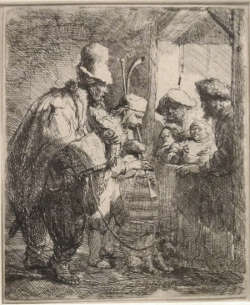
Strolling Musicians
Rembrandt van Rijn
etching, c. 1635
The State Hermitage Museum
St. Petersburg
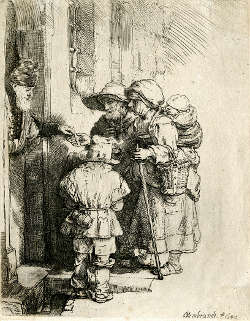
at the Door of a House
Rembrandt van Rijn
etching. 1648
Rijksmuseum, Amsterdam
The moment has shifted from the entertaining of the villagers to the bestowing of charity on the unfortunate. Rather than emphasizing the humiliation of the hurdy-gurdy player and his deplorable condition, Rembrandt stresses the act of giving.
Thus, the new identification of three [here: two] Rembrandt etchings proposed here allows us to trace a relatively common motif—the hurdy-gurdy player—through Rembrandt's works; and, as happens so often when dealing with Rembrandt's oeuvre, the content moves from an early interest in outward appearances to an insight into the meaningful interrelationships of man."
Hurdy-gurdy resources:
- Grove Music Online:
http://www.grovemusic.com - entry Hurdy-Gurdy: Francis Baines, Edmund A. Bowles, Roberta Green.
- Susann Palmer, Samuel Palmer. The Hurdy-Gurdy. Newton Abbot, London,
North Pomfret (Vt). 1980. - Kahren Jones Hellerstedt. Hurdy-gurdies from Hieronymus Bosch to Rembrandt. (diss.) University of Pittsburgh 1980.
- Hurdy-Gurdy maker Helmut Gotschy's site
http://www.gotschy.com/english/index.html - Musica Antiqua:
The Hurdy-gurdy (symphonia)
https://www.music.iastate.edu/antiqua/search/content/hurdy%20gurdy - Wikipedia:
Hurdy-gurdy
http://en.wikipedia.org/wiki/Hurdy_gurdy
Hurdy-gurdy extra:
- An extensive demonstration of playing the hurdy-gurdy, together with the bagpipe and the musette, the recorder and even the crumhorn can thoroughly be experienced in a video (click here) created by the Thornton School of Music at the University of Southern California. It is a c. forty-five minute live recording of an event entitled "Demonstration of rare instruments." The real demonstration, with detailed information" to all employed instruments (with the emphasis of the hurdy-gurdy), executed by two knowledgeable professional musicians, begins after some introductory words by the manager. Browsing through the video is possible (at least when using Windows media player) by moving the running search bar at the bottom of the player to the right or left. click here.